trunk release HONDA CIVIC COUPE 1999 Owners Manual
[x] Cancel search | Manufacturer: HONDA, Model Year: 1999, Model line: CIVIC COUPE, Model: HONDA CIVIC COUPE 1999Pages: 269, PDF Size: 2.42 MB
Page 4 of 269

Your Car at a Glance
DOOR LOCK
SWITCHES
(P.
70) MIRROR
CONTROLS
(P.
81)
HEATING/COOLING
CONTROLS
(P.
88)
AUDIO SYSTEM,
DIGITAL CLOCK
(P. 108)
POWER WINDOW
SWITCHES
(P.
79)
FUEL FILL
DOOR RELEASE
(P. 125)
TRUNK RELEASEHANDLE
(P.
75) HOOD RELEASE
HANDLE
(P. 126)Main Menu s t
Page 53 of 269
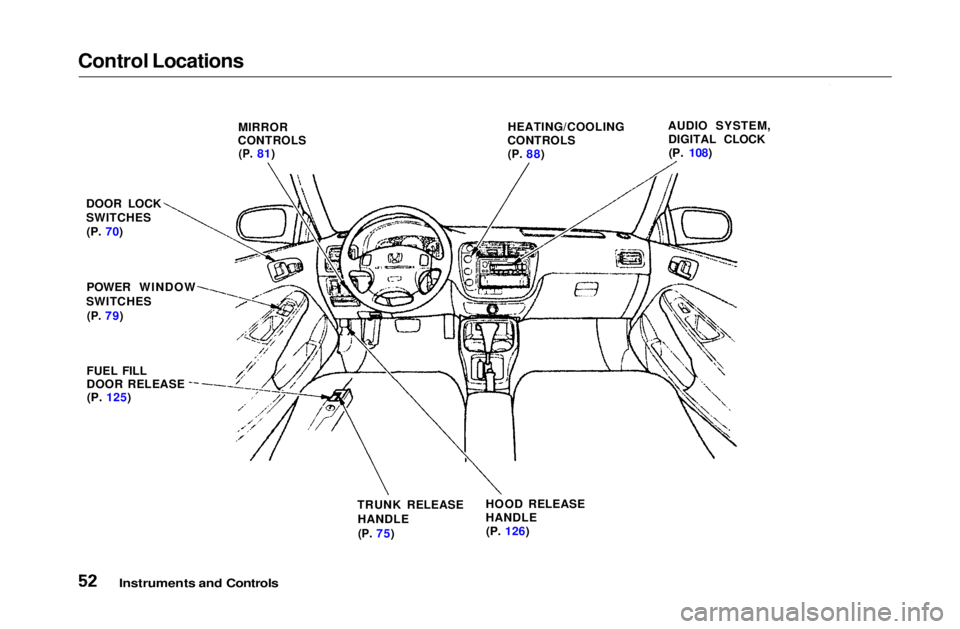
Control Locations
MIRROR
CONTROLS
(P.
81) HEATING/COOLING
CONTROLS
(P.
88) AUDIO SYSTEM,
DIGITAL CLOCK(P. 108)
DOOR LOCK
SWITCHES (P. 70)
POWER WINDOW
SWITCHES
(P.
79)
FUEL FILL
DOOR RELEASE (P. 125)
TRUNK RELEASEHANDLE
(P.
75) HOOD RELEASE
HANDLE
(P. 126)
Instruments and ControlsMain Menu Table of Contents s t
Page 70 of 269
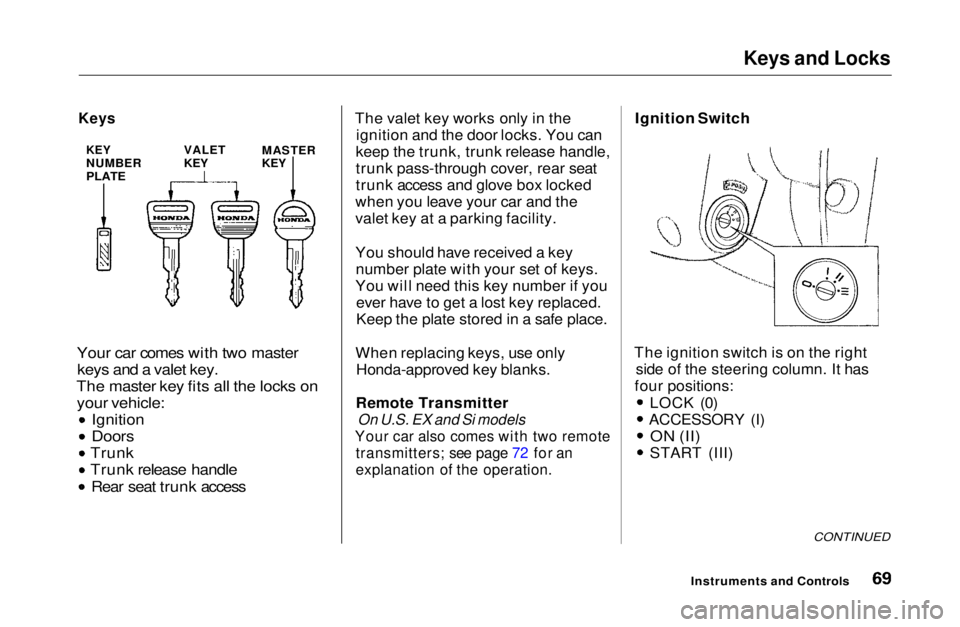
Keys and Locks
Your car comes with two master keys and a valet key.
The master key fits all the locks on your vehicle: Ignition
Doors
Trunk
Trunk release handle Rear seat trunk access
The valet key works only in the
ignition and the door locks. You can
keep the trunk, trunk release handle,
trunk pass-through cover, rear seat
trunk access and glove box locked
when you leave your car and the
valet key at a parking facility.
You should have received a key number plate with your set of keys.
You will need this key number if you ever have to get a lost key replaced.
Keep the plate stored in a safe place.
When replacing keys, use only Honda-approved key blanks.
Remote Transmitter
On U.S. EX and Si models
Your car also comes with two remote
transmitters; see page 72 for an
explanation of the operation.
Ignition Switch
The ignition switch is on the right side of the steering column. It has
four positions:
LOCK (0)
ACCESSORY (I)
ON (II)
START (III)
CONTINUED
Instruments and Controls
Keys
KEY
NUMBER
PLATE
VALET
KEY
MASTER
KEYMain Menu Table of Contents s t
Page 76 of 269

Keys and Locks
Trunk
You can open the trunk in two ways: Pull the trunk release handle to
the left of the driver's seat.
Use the master key to open the
trunk lock. The valet key does not
work in this lock. To close the trunk, press down on
the trunk lid.
See page 98 for cargo loading and
weight limit information. Keep the
trunk lid closed at all times while driving to avoid damaging the lid,
and to prevent exhaust gas from
getting into the interior. See Carbon
Monoxide Hazard on page 49. To protect items in the trunk when
you need to give the key to someone
else, lock the trunk release handle
with the master key and give the
other person the valet key.
Instruments and Controls
TRUNK RELEASE HANDLE
MASTER KEY
MASTER KEYMain Menu Table of Contents s t
Page 79 of 269
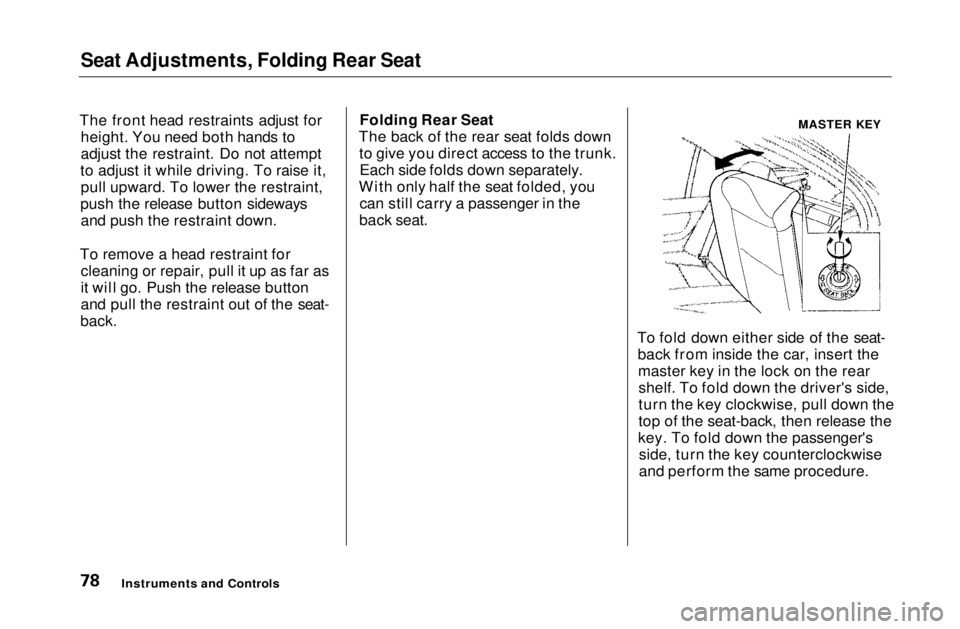
Seat Adjustments, Folding Rear Seat
The front head restraints adjust for height. You need both hands to
adjust the restraint. Do not attempt
to adjust it while driving. To raise it, pull upward. To lower the restraint,
push the release button sideways and push the restraint down.
To remove a head restraint for cleaning or repair, pull it up as far as
it will go. Push the release button
and pull the restraint out of the seat-
back. Folding Rear Seat
The back of the rear seat folds down to give you direct access to the trunk.Each side folds down separately.
With only half the seat folded, you can still carry a passenger in the
back seat.
To fold down either side of the seat-back from inside the car, insert themaster key in the lock on the rearshelf. To fold down the driver's side,
turn the key clockwise, pull down the
top of the seat-back, then release the
key. To fold down the passenger's side, turn the key counterclockwise
and perform the same procedure.
Instruments and Controls
MASTER KEYMain Menu Table of Contents s t
Page 80 of 269
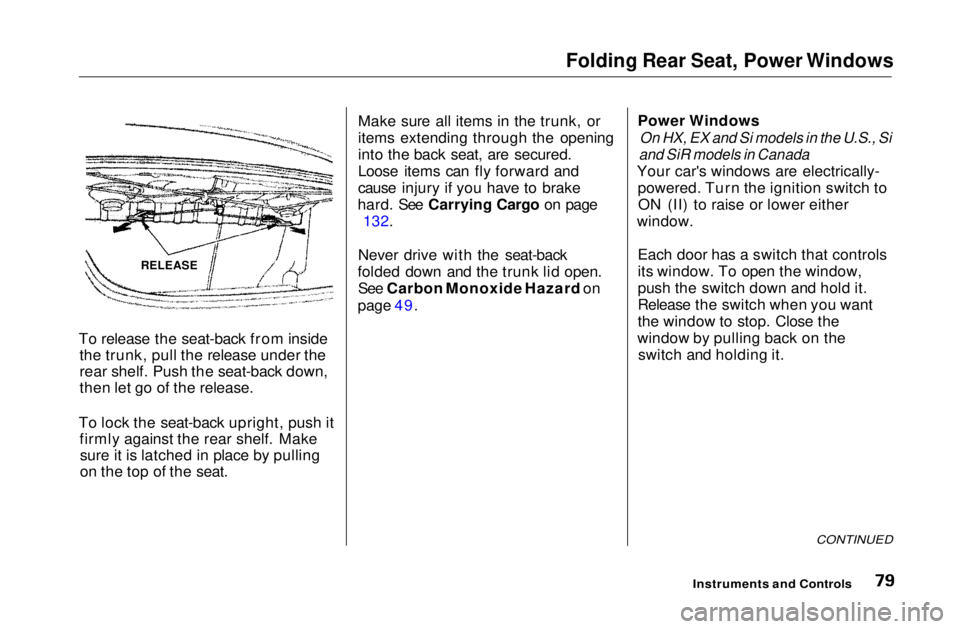
Folding Rear Seat, Power Windows
To release the seat-back from inside the trunk, pull the release under the
rear shelf. Push the seat-back down,
then let go of the release.
To lock the seat-back upright, push it firmly against the rear shelf. Makesure it is latched in place by pulling
on the top of the seat. Make sure all items in the trunk, or
items extending through the opening
into the back seat, are secured.
Loose items can fly forward and
cause injury if you have to brake
hard. See Carrying Cargo on page 132.
Never drive with the seat-back
folded down and the trunk lid open. See Carbon Monoxide Hazard on
page 49. Power Windows
On HX, EX and Si models in the U.S., Si
and SiR models in Canada
Your car's windows are electrically- powered. Turn the ignition switch toON (II) to raise or lower either
window.
Each door has a switch that controls
its window. To open the window,
push the switch down and hold it.
Release the switch when you want
the window to stop. Close the
window by pulling back on the switch and holding it.
CONTINUED
Instruments and Controls
RELEASEMain Menu Table of Contents s t
Page 149 of 269
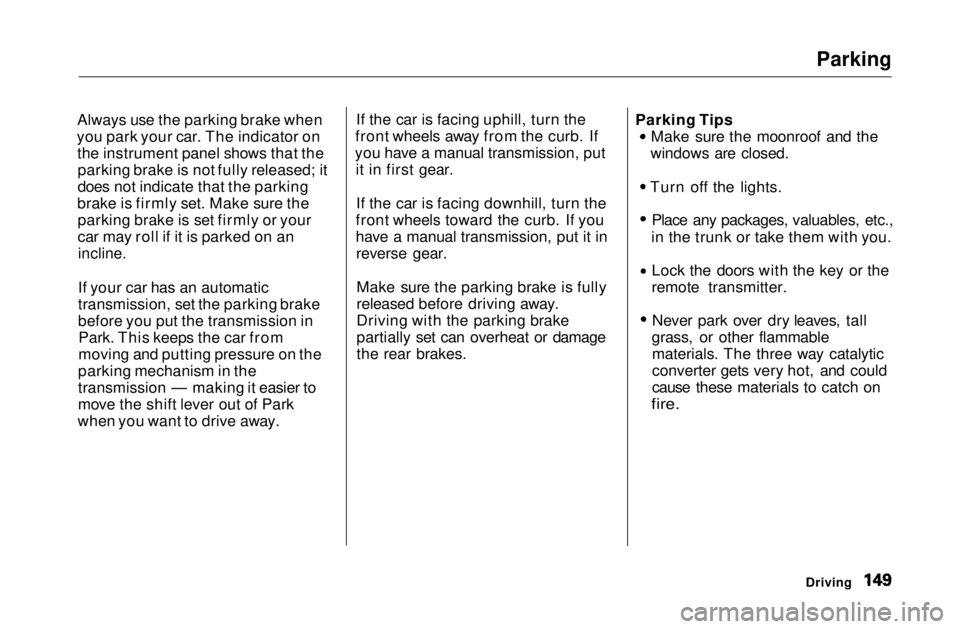
Parking
Always use the parking brake when
you park your car. The indicator on the instrument panel shows that theparking brake is not fully released; it
does not indicate that the parking
brake is firmly set. Make sure the parking brake is set firmly or your
car may roll if it is parked on an
incline.
If your car has an automatic
transmission, set the parking brake
before you put the transmission inPark. This keeps the car from
moving and putting pressure on the
parking mechanism in the
transmission — making it easier to
move the shift lever out of Park
when you want to drive away. If the car is facing uphill, turn the
front wheels away from the curb. If
you have a manual transmission, put it in first gear.
If the car is facing downhill, turn the
front wheels toward the curb. If you
have a manual transmission, put it in reverse gear.
Make sure the parking brake is fully
released before driving away.
Driving with the parking brake
partially set can overheat or damage
the rear brakes. Parking Tips Make sure the moonroof and the
windows are closed. Turn off the lights.
Place any packages, valuables, etc.,
in the trunk or take them with you. Lock the doors with the key or the
remote transmitter.
Never park over dry leaves, tall
grass, or other flammable materials. The three way catalytic
converter gets very hot, and could
cause these materials to catch on
fire.
DrivingMain Menu Table of Contents s t